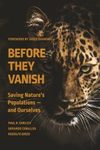Handbook / Manual
By: Michael L Morrison(Author), Leonard A Brennan(Author), Bruce G Marcot(Author), William M Block(Author), Kevin S McKelvey(Author)
244 pages, b/w illustrations, tables
Applications for Advancing Animal Ecology offers practical guidance for wildlife professionals working to improve study design, data analysis, and the application of results to habitat and population management.
![Applications for Advancing Animal Ecology Applications for Advancing Animal Ecology]()
Click to have a closer look
About this book
Contents
Customer reviews
Biography
Related titles
Recommended titles
About this book
Despite major advances in sampling techniques and analytical methods, many animal ecologists conduct research that is primarily relevant to a specific time and place. They also tend to focus more on the statistical analyses and nuances of modeling than actual study design. Arguing that studies of animal ecology should always begin with a focus on the behaviors and characteristics of individual organisms, including how they form into distinct biological populations, Applications for Advancing Animal Ecology takes a fresh and critical look at the field.
Building from its companion volume, Foundations for Advancing Animal Ecology, this practical book presents readers with the principal methods used to observe animal behavior. Teaching them to assess resource abundance categories of species-environmental relationships models, it also explores
- major aspects of measuring animal habitat: what to measure and how to measure it;
- common sampling and estimation methods to assess population parameters;
- when to measure and how to analyze data;
- problems that will confront ecologists in the coming years – and how to gather information to adequately address them; and
- how the experimental approach can be used to advance the science of animal ecology.
Throughout the book, the authors stress the importance of speaking a common and well-defined language. Avoiding vague and misleading terminology, they assert, will help ecologists translate science into meaningful and lasting actions in the environment. Taking the perspective of the organism of interest in developing concepts and applications, the authors always keep the potentially biased human perspective in focus. They also provide a selection of suggested research projects, cautions, and caveats. A major advancement in understanding the factors underlying wildlife–habitat relationships, Applications for Advancing Animal Ecology will be an invaluable resource to natural resource management professionals and practitioners, including state and federal agencies, non-governmental organizations, and environmental consultants.
Contents
Preface
Chapter 1: The Experimental Approach in Animal Ecology
Chapter 2: Measurement of Animal Habitats and Populations Parameters for Habitat Classification
Chapter 3: Measurement of Animal Habitat: When and Where to Measure and How to Analyze
Chapter 4: Measuring Behavior
Chapter 5: Modeling Species-Environment Relationships
Chapter 6: Where We Go from Here: New Imperatives and the Road Forward
Customer Reviews
Biography
Michael L. Morrison is a professor and the Caesar Kleberg Chair in the Department of Rangeland, Wildlife, and Fisheries Management at Texas A&M University. He is the coauthor of Ornithology: Foundation, Analysis, and Application. Leonard A. Brennan is a research scientist and is the C. C. Winn Endowed Chair for Quail Research Professor at the Caesar Kleberg Wildlife Research Institute, Texas A&M University–Kingsville. He is the coeditor of Quantitative Analyses in Wildlife Science. Bruce G. Marcot is a research wildlife biologist with the USDA Forest Service, Pacific Northwest Research Station, and the coauthor of Wildlife-Habitat Relationships: Concepts and Applications. William M. Block is scientist emeritus with the USDA Forest Service, Rocky Mountain Research Station. He is the coauthor of Wildlife Study Design. Kevin S. McKelvey is a research ecologist with the USDA Forest Service, Rocky Mountain Research Station. He is the coauthor of Ecology and Conservation of Lynx in the United States.
Handbook / Manual
By: Michael L Morrison(Author), Leonard A Brennan(Author), Bruce G Marcot(Author), William M Block(Author), Kevin S McKelvey(Author)
244 pages, b/w illustrations, tables
Applications for Advancing Animal Ecology offers practical guidance for wildlife professionals working to improve study design, data analysis, and the application of results to habitat and population management.








































